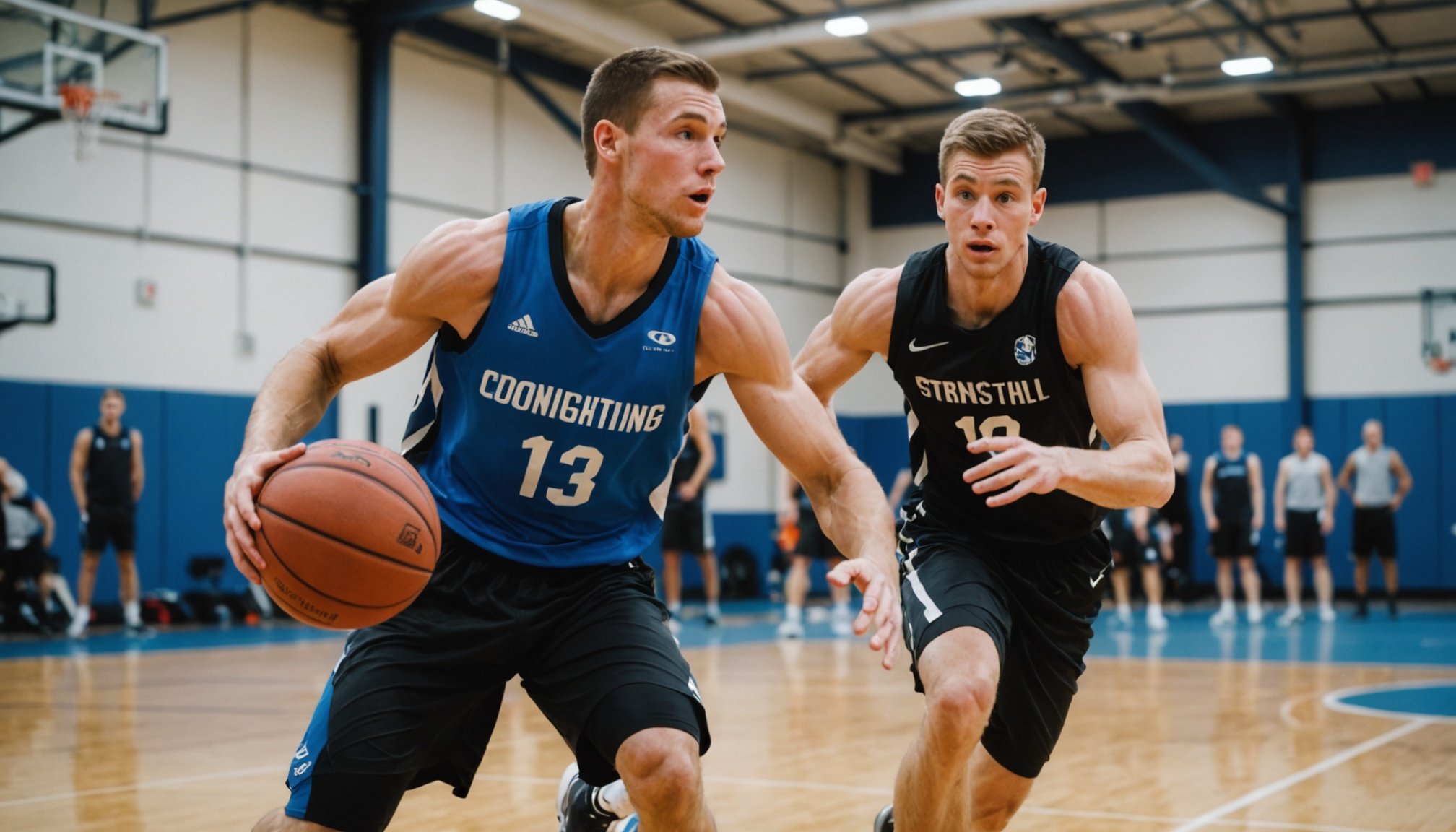The Importance of Strength and Conditioning in Basketball Performance
Recognising the importance of strength and conditioning in basketball can greatly enhance athletic performance. Utilizing principles of athletic training, players can improve not only their physical abilities but also reduce injury risks. By strengthening muscles and improving endurance, athletes maintain competitive edge.
Strength and conditioning in basketball focuses on enhancing athletic performance metrics such as speed, agility, and vertical leap. These are crucial for making quick, effective plays during a game. Proper training can refine these skills, leading to superior on-court performance.
Moreover, conditioning plays a significant role in injury prevention and recovery. Building stronger muscles and better joint flexibility can mitigate the risk of injuries such as sprains or tears. It can also speed up recovery times if injuries do occur. This aspect is vital for maintaining long-lasting athletic careers.
Engaging in well-structured conditioning programs can immensely benefit basketball players. This structured approach fosters not just physical growth but also mental resilience, an often-overlooked component of sports training. Focusing on both physical and mental aspects can lead to comprehensive improvements in a player’s game.
Also to read : Maximizing Game Performance: Strategies for UK Basketball Teams to Optimize Travel Schedules
Key Strength and Conditioning Exercises for Basketball Athletes
Incorporating diverse strength training exercises is vital for basketball athletes aiming to enhance overall performance. These exercises lay the foundation for greater agility, power, and endurance on the court. By focusing on key areas, players can achieve significant improvement in their game.
Weightlifting Strategies
Basketball athletes benefit greatly from weightlifting, targeting both upper and lower body muscles. Emphasizing compound movements such as squats and deadlifts can build the necessary lower body strength, boosting vertical jump capabilities. Meanwhile, exercises like bench presses and rows fortify the upper body, contributing to more powerful court maneuvers.
Plyometric Exercises
Plyometric exercises are integral for developing explosive power, essential for impactful jumps and sprints. Drills such as box jumps and clap push-ups focus on quick, forceful movements, enhancing muscle responsiveness and reducing fatigue during play. These exercises are key in enhancing vertical jump capabilities.
Agility and Speed Drills
Agility and speed improvements are effectuated through targeted drills, designed to polish lateral movement and quickness. Techniques like cone drills and ladder drills refine coordination and balance, enhancing a player’s on-court agility. Focusing on rapid changes in direction enhances not only physical speed but also sharpens reflexive responses during high-pressure game situations.
Success Stories and Case Studies
Understanding the journey of successful basketball athletes showcases the profound impact of athletic success and performance enhancement driven through meticulously designed training. In the UK, numerous athletes have elevated their careers by adhering to structured strength and conditioning regimens. Notable figures have shared how customized training methodologies directly contributed to their achievements, underscoring the importance of individualized approaches.
Some athletes have demonstrated that adapting specific exercises, such as plyometric drills and weightlifting strategies, can significantly amplify their game performance. For instance, one athlete attributed their improved vertical leap to a focused plyometric routine, highlighting how essential such exercises are in professional training landscapes.
Additionally, successful coaches often incorporate lessons learned from effective training practices. They emphasize understanding each athlete’s strengths and weaknesses to tailor programs that foster both physical and mental growth. This commitment to personalized coaching has been pivotal in achieving exceptional on-court results.
These success stories not only serve as inspiration but also offer practical insights into implementing training strategies effectively. By studying these examples, players and coaches can gain valuable knowledge about the right balance between strength, conditioning, and targeted development for maximizing athletic potential.
Tailoring Training Programs for UK Basketball Athletes
Developing an effective basketball training program requires recognising each athlete’s individualised needs. Understanding their specific goals is crucial. Athletes might aim for enhancing vertical leap, boosting agility, or improving endurance. Crafting a program around these objectives cultivates an environment primed for athletic development.
Incorporating sport-specific movements is essential. Movements that mimic game scenarios, such as quick directional changes and sprint drills, should be included. These exercises allow players to practice in contexts they often face during competition, fostering on-court adaptability.
Adapting programs based on the athlete’s competitive level is vital to ensure growth. Beginners may focus on fundamental skills and general conditioning, while advanced players might engage in more complex workouts targeting elite performance metrics. Tailoring exercises to match player capacity keeps training challenging, yet achievable.
Personalised basketball training programs facilitate targeted improvements in all skill levels. By working closely with coaches and trainers, athletes can benefit from professional insights and enhanced support. This bespoke approach nurtures both physical prowess and mental confidence, paving the way for sustained athletic success in competitive basketball.
Expert Opinions on Strength and Conditioning
Gaining insights from expert advice in strength and conditioning can significantly enhance athlete development. Professionals in the field offer valuable perspectives on optimizing basketball performance through well-structured training.
Interview Insights from Coaches
Coaches highlight the importance of evidence-based practices in designing effective training programs. They emphasize adapting exercises to meet individual athlete needs, ensuring that workouts remain challenging yet attainable. Focusing on an athlete’s unique skill set is crucial for maximizing training effectiveness.
Opinions from Strength and Conditioning Specialists
Strength and conditioning specialists stress the importance of balanced approaches. They highlight that incorporating diverse exercises—such as weightlifting, plyometrics, and agility drills—is vital for comprehensive athletic improvement. Specialists advise athletes to prioritize building both power and endurance for enriched basketball performance.
Research Trends in Athletic Training
Recent studies underscore emerging trends that challenge common misconceptions in athletic training. Emphasizing recovery and nutrition is fundamental, as these play pivotal roles in maintaining athlete health and performance. By staying informed about cutting-edge conditioning strategies, athletes and coaches can maintain competitive advantages.
Practical Tips for Implementing Strength and Conditioning
To enhance athlete development effectively, integrating practical training tips is essential. Creating a balanced workout routine involves combining diverse exercises like weightlifting, plyometrics, and agility drills. This ensures that players build both strength and endurance, crucial for improved basketball performance. Equally important is understanding the role of recovery and nutrition. Prioritising adequate rest periods and a nutrient-rich diet supports muscle repair and boosts energy levels, facilitating optimal performance during training sessions and games.
Monitoring progress regularly helps in making necessary adjustments to training routines. By analysing metrics like speed, agility, and power, athletes can pinpoint areas needing refinement, ensuring continuous development. Feedback from coaches and training experts is invaluable in this process, providing insights into personalised improvements and helping athletes stay on track.
Implementing these effective conditioning strategies fosters a disciplined yet dynamic training environment. Remember, the essence of a well-rounded training program lies in its ability to evolve alongside the athlete’s growth and specific needs. As athletes embrace these tailored methods, they position themselves to unlock their full potential, gaining a competitive edge on the court.











